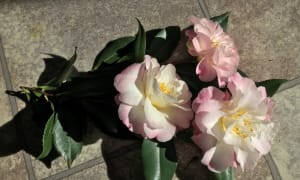
Pink Fingers were spotted on the recent Wildflower Walk hosted by Narrandera Landcare. Photo: Rowena Whiting
By Nella Smith
Twenty people (the maximum allowed at this time of COVID) who all registered for the Narrandera Landcare’s Wildflower Walk gathered at the top of the hill with such enthusiasm on the morning of August 30, led by Narrandera Landcarer Glenn Currie.
You would never think that a rocky hill with skeletal soil could be so floristically diverse.
Looking across the area you could see the blues of the Blue Crowfoot and the yellow of the Sticky Everlasting.
There is a fantastic ground layer of herbs, forbs, orchids and lilies. The yellow orchids with petals shaped like donkey’s ears are commonly found. These rely on specific mycorrizal fungi to help them gather nutrients and specific insects for pollination, so there’s no point in digging them for your garden as they won’t make it (moreover it is illegal).
The other orchids we saw were Midget and Dwarf Greenhoods which have a little trapdoor which closes when the tiny gnat alights and traps it. It frantically buzzes around collecting a little pollen before it can escape to pollinate the next orchid.
Pink Fingers, a bright purple Waxlip and a Spider orchid was also found and admired.
A carnivorous plant that we saw is called a Sundew has a sticky substance on its leaves which traps insects and eventually dissolves them for nutrients.
The lilies range from the tiny Early Nancy to the taller yellow-flowering Bulbine Lily and the purple of the Chocolate and Vanilla lilies which really do have a scent of chocolate and vanilla. It was so good to see the taller Nodding Blue Lily and the purple of the Australian Indigo emerging again after a long dry spell.
Visually the Western Golden Wattle stole the show as it was flowering at its spectacular best. We also have another wattle up there with ‘pipe cleaner” type flowers one of only a few like that in Australia but it flowers a little later – this is the Currawang.
The other trees to be found in that patch are the multi-stemmed Dwyer’s Mallee Gum and the White Cypress Pine.
It was a great way to spend a sunny Sunday morning in Spring. This Spring is particularly good for both growing crops and wildflowers. We have natural unspoilt environments in our region that are arguably equal to those found in other well-known parts of Australia.
These are becoming scarcer as production and grazing reduce the last remaining parts.
I was really pleased with the interest and engagement I saw on the day with the people who attended and I hope you learn to love the natural areas like we do.
Thanks to Glenn Currie for organising this and for doing all the research.





